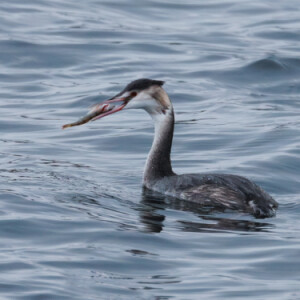Wintry
I didn't drive all the way to Farmoor Reservoir this afternoon to take photos of Great Crested Grebes, Cormorants, Pied Wagtails, and Tufted Ducks, but that's mainly what I arrived home with. I'd been hoping to see the Slavonian Grebe that turned up there on Saturday, but I knew this was a long shot because it hadn't been reported again yesterday, so I wasn't surprised to discover that it had moved on. A local birder I chatted to as we both circuited Farmoor 2 told me that the reservoir is busy with sailors and wind-surfers on Saturdays, as well as the usual guys fishing from small motor boats, and he doubted that a small, lone migrant would have stayed very long under those circumstances. Slavonian Grebes are never common in the UK, though our estimated winter population of around 1000 birds is internationally significant, and the Farmoor visitor was most probably making a refuelling stop en route to the east or south coast, where it will spend the winter offshore.
Deprived of one bird I'd never seen before, I did manage another, when I encountered a Snow Goose on the western bank of the reservoir. My new acquaintance pointed out a large flock of these birds in a distant field, and told me that they've naturalised in Oxfordshire over the past few years, and are now breeding. Sadly, the individual at the reservoir was trailing a wing that was either injured or congenitally deformed, and was therefore left behind when the rest of the flock went off to feed, but I was told that it's been in this state for quite a while now, and seems somehow to be coping with its circumscribed life.
Because of its damaged wing I only took record shots of the Snow Goose for my own reference, and the pair of Goldeneyes that were the next most interesting birds at the reservoir today were too distant for anything better than record shots either. Which is why I ended up falling back on the usual suspects. I've posted Great Crested Grebes so many times now that I don't really have anything to say about them, except to note how drab their winter plumage is compared to their breeding finery: like all grebes, they turn virtually monochrome outside the breeding season. They are still quite distinctive though - as I scanned the water today I picked them out very easily among the groups of ducks and geese, and I realised that there's something about their winter head plumage that puts me quite strongly in mind of a Peaky Blinders undercut.
My second image tonight is the last shot of the afternoon - a different Great Crested Grebe with its dinner.


Comments
Sign in or get an account to comment.


